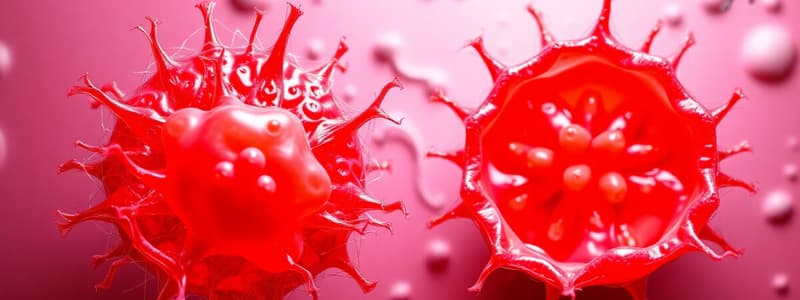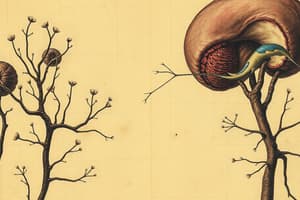Podcast
Questions and Answers
What does atrophy refer to?
What does atrophy refer to?
- Increase in cell size
- Decrease in cell size (correct)
- Normal adaptation to pregnancy
- Increase in the number of cells
Hypertrophy can occur as a result of excessive hormonal stimulation.
Hypertrophy can occur as a result of excessive hormonal stimulation.
True (A)
What is hyperplasia?
What is hyperplasia?
An increased number of cells resulting in enlarged tissue mass.
Cellular changes due to reduced use of tissue, insufficient nutrition, or aging are referred to as __________.
Cellular changes due to reduced use of tissue, insufficient nutrition, or aging are referred to as __________.
Match the following terms with their definitions:
Match the following terms with their definitions:
Which change is likely to occur in muscle tissue as a result of consistent exercise?
Which change is likely to occur in muscle tissue as a result of consistent exercise?
All cellular adaptations are reversible after the stimulus is removed.
All cellular adaptations are reversible after the stimulus is removed.
Name a common condition that may lead to atrophy.
Name a common condition that may lead to atrophy.
What is necrosis?
What is necrosis?
Lysosomal enzymes released from dead cells can cause inflammation and damage to nearby cells.
Lysosomal enzymes released from dead cells can cause inflammation and damage to nearby cells.
What enzyme levels are often tested to indicate a heart attack?
What enzyme levels are often tested to indicate a heart attack?
Coagulative necrosis occurs typically in cases of __________ due to lack of oxygen.
Coagulative necrosis occurs typically in cases of __________ due to lack of oxygen.
Anaplasia is typically seen in benign tumors.
Anaplasia is typically seen in benign tumors.
What characterizes dysplasia in tissue cells?
What characterizes dysplasia in tissue cells?
Match the type of necrosis with its description:
Match the type of necrosis with its description:
________ is a programmed cell death process.
________ is a programmed cell death process.
Which type of necrosis is typically associated with tuberculosis?
Which type of necrosis is typically associated with tuberculosis?
Match the following cellular conditions with their descriptions:
Match the following cellular conditions with their descriptions:
Gangrene is caused solely by bacterial infection.
Gangrene is caused solely by bacterial infection.
What can result from hypoxia in tissue?
What can result from hypoxia in tissue?
What occurs when infarction happens in the heart muscle?
What occurs when infarction happens in the heart muscle?
All benign tumors can become malignant.
All benign tumors can become malignant.
In __________ necrosis, the tissue becomes cold, swollen, and black due to liquefaction.
In __________ necrosis, the tissue becomes cold, swollen, and black due to liquefaction.
Match the following descriptions with the type of gangrene:
Match the following descriptions with the type of gangrene:
What is the effect of dead cells releasing enzymes into the bloodstream?
What is the effect of dead cells releasing enzymes into the bloodstream?
Ciliated columnar epithelium can be replaced by _______ in the respiratory tracts of smokers.
Ciliated columnar epithelium can be replaced by _______ in the respiratory tracts of smokers.
Fat necrosis only occurs in the absence of inflammation.
Fat necrosis only occurs in the absence of inflammation.
Which condition refers to new growth or tumors?
Which condition refers to new growth or tumors?
How does tissue regenerate after cell death?
How does tissue regenerate after cell death?
Infection from microorganisms cannot lead to cell injury.
Infection from microorganisms cannot lead to cell injury.
What is the hallmark of apoptosis?
What is the hallmark of apoptosis?
________ refers to the condition where cells vary in size and shape along with an increased rate of mitosis.
________ refers to the condition where cells vary in size and shape along with an increased rate of mitosis.
Which of the following is a cause of ischemia?
Which of the following is a cause of ischemia?
Flashcards
Atrophy
Atrophy
A decrease in the size of cells, resulting in a reduced tissue mass.
Hypertrophy
Hypertrophy
An increase in the size of individual cells, resulting in an enlarged tissue mass.
Hyperplasia
Hyperplasia
An increased number of cells resulting in an enlarged tissue mass.
Adaptive Cellular Changes
Adaptive Cellular Changes
Signup and view all the flashcards
Irreversible Cellular Changes
Irreversible Cellular Changes
Signup and view all the flashcards
Cellular Adaptation
Cellular Adaptation
Signup and view all the flashcards
Homeostasis
Homeostasis
Signup and view all the flashcards
DNA
DNA
Signup and view all the flashcards
Necrosis
Necrosis
Signup and view all the flashcards
Liquefactive Necrosis
Liquefactive Necrosis
Signup and view all the flashcards
Coagulative Necrosis
Coagulative Necrosis
Signup and view all the flashcards
Fat Necrosis
Fat Necrosis
Signup and view all the flashcards
Caseous Necrosis
Caseous Necrosis
Signup and view all the flashcards
Granuloma
Granuloma
Signup and view all the flashcards
Ghon Focus
Ghon Focus
Signup and view all the flashcards
Infarction
Infarction
Signup and view all the flashcards
Gangrene
Gangrene
Signup and view all the flashcards
Dry Gangrene
Dry Gangrene
Signup and view all the flashcards
Wet Gangrene
Wet Gangrene
Signup and view all the flashcards
Gas Gangrene
Gas Gangrene
Signup and view all the flashcards
Creatine Phosphokinase (CPK)
Creatine Phosphokinase (CPK)
Signup and view all the flashcards
Troponin
Troponin
Signup and view all the flashcards
Tissue Regeneration
Tissue Regeneration
Signup and view all the flashcards
Metaplasia
Metaplasia
Signup and view all the flashcards
Dysplasia
Dysplasia
Signup and view all the flashcards
Anaplasia
Anaplasia
Signup and view all the flashcards
Neoplasia
Neoplasia
Signup and view all the flashcards
Apoptosis
Apoptosis
Signup and view all the flashcards
Ischemia
Ischemia
Signup and view all the flashcards
Hypoxia
Hypoxia
Signup and view all the flashcards
Pyroptosis
Pyroptosis
Signup and view all the flashcards
Reversible Cell Damage
Reversible Cell Damage
Signup and view all the flashcards
Irreversible Cell Damage
Irreversible Cell Damage
Signup and view all the flashcards
Physical Injury
Physical Injury
Signup and view all the flashcards
Chemical Injury
Chemical Injury
Signup and view all the flashcards
Infectious Injury
Infectious Injury
Signup and view all the flashcards
Study Notes
Cellular Adaptations
- Cells adapt growth and differentiation to body changes.
- Normal adaptations include increased breast/uterine tissue in pregnancy.
- Tissue modifications often reverse after stimulus removal.
- Disease develops when cells change, preventing homeostasis.
- Irreversible changes signal DNA structure/function alterations.
- Abnormal changes aren't always cancerous, monitor for issues.
- Cell damage can result from metabolic shifts, ATP reduction, pH changes, or membrane/receptor damage.
Types of Cellular Adaptations
-
Atrophy: Decrease in cell size, reduced tissue mass.
- Causes: reduced use, insufficient nutrition, decreased hormonal/neurological stimulation, aging.
- Example: immobilized limb muscle shrinkage.
-
Hypertrophy: Increase in cell size, enlarged tissue mass.
- Causes: increased tissue work, demands (e.g., enlarged heart muscle).
- Example: Exercise-induced skeletal muscle enlargement.
-
Hyperplasia: Increased cell number, enlarged tissue mass.
- Causes: compensatory mechanisms to meet demands, hormonal imbalances.
- Example: Uterine enlargement during pregnancy.
- Potential link to cancer risk in some cases.
-
Metaplasia: One mature cell type replaces another.
- Causes: Vitamin A deficiency or environmental stimuli (e.g., cigarette smoke in respiratory tract).
- Example: stratified squamous epithelium replacing ciliated columnar in smokers.
- Reduced lung defenses due to loss of cilia.
-
Dysplasia: Tissue cells with varied size/shape, large nuclei, increased mitosis.
- Causes: chronic irritation/infection, potential precancerous change.
- Diagnosis: Routine screening, such as Pap smear (cervical cells).
-
Anaplasia: Undifferentiated cells with variable nuclear/cell structures, numerous mitotic figures.
-
Sign of aggressive tumor growth. Common in malignant tumors. Basis for tumor grading.
-
Neoplasia: New growth, aka tumor.
- Types: Benign (less serious, usually do not spread)
- Types: Malignant (cancerous, can spread)
- Characteristics vary depending on cell origin.
- Further discussion in Chapter 20
Cell Damage and Necrosis
-
Apoptosis: Programmed cell death (normal).
- Increases with abnormal development, excessive cell numbers, or injury/aging.
- Cells self-digest into apoptotic bodies, engulfed without inflammation.
-
Necrosis: Cell/tissue death from irreversible damage (not programmed).
- Causes: ischemia, physical/chemical agents, mechanical damage, infection, metabolic imbalance, nutritional/electrolyte deficiencies.
- Hypoxia: Reduced oxygen in tissue, a significant cause of cell damage. Can lead to cell swelling and rupture.
-
Cell Injury Stages: Initial alteration in metabolic reaction leading to loss of function (reversible if damage factor removed). Increased damage leads to structural/morphological changes.
-
Types of Necrosis:
- Liquefactive: Dead cells liquefy (e.g., brain infarction, infections).
- Coagulative: Protein alteration (denaturation), cells maintain structure for a while (e.g., heart attack).
- Fat: Fatty tissue breakdown into fatty acids (e.g., infection).
- Caseous: Thick, yellowish, "cheesy" substance (e.g., TB).
- Infarction: Area of dead cells from lack of oxygen (e.g., heart attack).
-
Gangrene: Necrotic tissue, often due to poor blood supply and infection.
- Types: Dry (coagulative necrosis, tissue dries, shrinks, blackens)
- Types: Wet (liquefaction necrosis, tissue becomes cold, swollen, black)
- Gas gangrene: Build-up of gases further reduces blood supply.
- Frequently requires surgical removal (amputation).
Diagnostic Findings
- Cell/tissue death can lead to enzyme release into the blood. The presence of specific enzymes can identify the damaged tissue type (e.g., cardiac enzymes indicating heart attack).
Studying That Suits You
Use AI to generate personalized quizzes and flashcards to suit your learning preferences.




